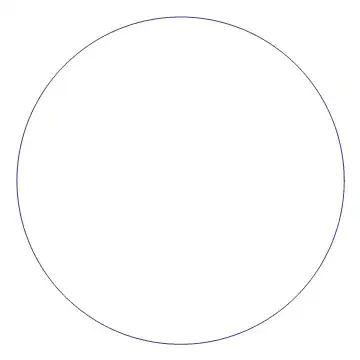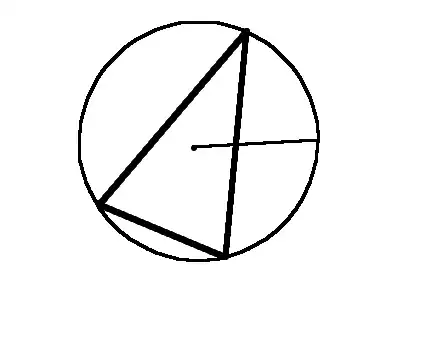I'm looking for a bijection from a circle to a triangle that is continuous with a continuous inverse. What could be one?
-
2More generally: http://math.stackexchange.com/questions/298311/subset-of-mathbb-rn-homeomorphic-to-sphere – Seirios Jun 18 '13 at 07:02
4 Answers
Here is an animation I made exhibiting such a homeomorphism:

Mathematica code:
CirclePoint[t_] := {Cos[2 Pi t], Sin[2 Pi t]}
TrianglePoint[t_] :=
If[0 <= t < 1/3,
{((1-(3t))+(-1/2) (3t)), -(1/Sqrt[3])(((1-(3t))+(-1/2)(3t))+1/2)+Sqrt[3]/2},
If[1/3 <= t < 2/3,
{-1/2, (1-(3t-1))Sqrt[3]/2+(3t-1)(-Sqrt[3]/2)},
{((-1/2)(1-(3t-2))+(3t-2)),
(1/Sqrt[3])(((-1/2)(1-(3t-2))+(3t-2))+1/2)-Sqrt[3]/2}]]
CircleTriangle[s_] :=
ParametricPlot[(1-s) CirclePoint[t] + s TrianglePoint[t], {t, 0, 1},
PlotRange -> {{-1.1, 1.1}, {-1.1, 1.1}}, Ticks -> None, Axes -> False]
Export["animation2.gif",
Join[Table[CircleTriangle[Max[s, 0]], {s, -0.1, 1, 0.02}],
Table[CircleTriangle[Min[s, 1]], {s, 1.1, 0, -0.02}]],
"DisplayDurations" -> 0.1]
- 129,973
-
1This is a sweet animation, but downvoted because it outlines a homotopy, not a homeomorphism per se. – dfeuer Jun 18 '13 at 06:22
-
2@dfeuer: Did you downvote eccstartup's answer for giving a triangle inscribed in a circle, which is technically something other than a homeomorphism? Or is it possible that giving a visual intuition for what the homeomorphism is at least as useful as describing it explicitly but opaquely? Incidentally, your answer is exactly the same homeomorphism as all other answers provided so far (you can even look at my code to see exactly how it was made). – Zev Chonoles Jun 18 '13 at 06:58
-
@ZevChonoles, no, it is not. It matches up vertices of the triangle to corresponding points on the circle in the same way if the triangle is equilateral, but it behaves differently in between. eccstartup's answer I saw as an illustration of André's. – dfeuer Jun 18 '13 at 07:10
-
Don't get me wrong... I appreciate your answer. It just doesn't match this particular question. – dfeuer Jun 18 '13 at 07:11
-
@dfeuer: Very well, it is different than Andre's and eccstartup's, but it is the same as mine; both the triangle and the circle are parametrized by cumulative perimeter, starting from the point $(1,0)$. But I am still curious why the graphic contained in eccstartup's answer, which just provides a circle, triangle, and line, and not a homeomorphism, did not get a downvote from you. – Zev Chonoles Jun 18 '13 at 07:20
-
@dfeuer: I appreciate that you liked the animation, but I am defending its usefulness / validity as an answer to this question. Would you feel more comfortable if I edited my answer to say "Here is an animation I made that may give you the intuition for such a homeomorphism"? – Zev Chonoles Jun 18 '13 at 07:25
-
1It seems that the point of @dfeuer was that your animation shows a homotopy and not a homeomorphism. This means, your animation shows a function $F(x,t)$ where $F(\cdot,0):[0,1]\to \mathbb{R}^2$ parameterizes a circle and $F(x,1)$ a triangle. You could add after the animation, however, that one can obtain the homeomorphism $f:C\to T$ by mapping the points $C:={ F( x ,0) | 0\le x\le 1 }$ of the circle to the points of the triangle $T= { F(x,1) | 0\le x \le 1 }$, so defining $f(x):=F(x,1)$ is the desired homeomorphism. You can then argue that the homotopy is continuous and so also $f$. – exchange Jun 17 '20 at 16:24
-
I will assume that by circle you mean the curve, not the disk, and also that by triangle you mean the "curve" consisting of three line segments. In a remark at the end, we mention how to modify things if we are dealing with a disk and a triangle-with-interior.
We are given a circle $C$ and a triangle $T$. Draw the incircle $C^\ast$ of $T$. There is a natural bijection $\varphi$ from $C$ to $C^\ast$ (scale and translate).
We will produce a bijection from $C^\ast$ to $T$. Let $O$ be the centre of $C^\ast$, and let $P$ be any point on $C^\ast$. Draw the half-infinite ray $OP$. This ray meets the triangle at a uniquely defined point. Let $\psi(P)$ be that point. Then $\psi$ is a continuous bijection with continuous inverse from $C^\ast$ to $T$, so $\psi\circ\varphi$ is a continuous bijection from $C$ to $T$, with continuous inverse.
Remark: Using a similar idea, we can find a continuous bijection with continuous inverse from any disk $C$ to the figure made up of a triangle and its interior. All we need to do is to modify the definition of $\psi$. Let $O$ be the centre of the disk $C^\ast$, and let $P$ be a point on the boundary of that disk. Suppose that the ray $OP$ meets the boundary of the triangle at $Q$, and let $X$ be a point in the disk and on the line segment $OP$. Map $X$ to the point $Y$ on the line segment $OP$ such that $\frac{OY}{OX}=\frac{OQ}{OP}$.
- 507,029
-
umm... what about obtuse triangles? You'll need to tweak the bijection a little. – John Dvorak Jun 18 '13 at 10:00
-
@JanDvorak: Yes, thanks, will need to be away for a while, but fix is easy, will be made in few hours. – André Nicolas Jun 18 '13 at 11:04
I'm just answering to add a different homeomorphism: match arc length along the circle to cumulative perimeter along the triangle.
- 9,069
